Podcast
Show Notes
Solar activity measured in ice
- Lund University press release
- “Cosmogenic radionuclides reveal an extreme solar particle storm near a solar minimum 9125 years BP,” Chiara I. Paleari et al., 2022 January 11, Nature Communications
Mimas joins “ocean world” club
- An Ocean May Lurk Inside Saturn’s ‘Death Star’ Moon (The New York Times)
- “The case for an ocean-bearing Mimas from tidal heating analysis,” Alyssa Rose Rhodena and Matthew E. Walker, 2022 January 4, Icarus
Mars’ history of water gets more confusing
- SwRI press release
- “Assessing the role of clay and salts on the origin of MARSIS basal bright reflections,” Elisabetta Mattei et al., 2022 January 19, Earth and Planetary Science Letters
Mars’ history of water stays confusing
- NASA JPL press release
- “Evidence for Deposition of Chloride on Mars From Small-Volume Surface Water Events Into the Late Hesperian-Early Amazonian,” Ellen K. Leask and Bethany L. Ehlmann, 2021 December 27, AGU Advances
New weird radio source raises excitement
- ICRAR press release
- “A radio transient with unusually slow periodic emission,” N. Hurley-Walker et al., 2022 January 26, Nature
What’s Up: Learn how to use that telescope
- QuikFinder (Rigel Systems)
- Telrad Sight (Company Seven)
Transcript
Hello and welcome to the Daily Space. I am your host Dr. Pamela Gay.
And I am your host Beth Johnson.
And we’re here to put science in your brain.
Scientists using the Murchison Widefield Array in Australia recently discovered an extremely bright source of radio waves, releasing bursts of energy three times an hour. That timing makes the object behave unlike anything else seen to date, leaving the research team with a new mystery to unravel.
Plus, everything else is about water today, all over the solar system, and we present this week’s What’s Up segment. Did you get a telescope for the holidays? We can help you get started.
Before we begin the show, however, let’s take a moment to honor the brave men and women who lost their lives in the advancement of space and science – the crews of Apollo 1 and the space shuttles Challenger and Columbia – today, January 27, NASA’s Day of Remembrance.
And now let’s launch into the Daily Space.

As humans, we really struggle to understand the expansiveness of time. We get excited about once-a-century storms and forget that where once-a-century events may be exciting, for every ten of them there is an even bigger once a millennium event and even a larger once per 10,000-year event. Our history hasn’t always done a good job convincing us the trials of past, low technology societies, reflect issues that can be devastating to our modern world.
Consider the Sun. It has been hanging out with Earth since before our world even had a moon. We periodically worry about solar flares or coronal mass ejections knocking out a few satellites, but it turns out we are not worrying nearly enough.
New research appearing in Nature Communications and led by Chiara Paleari describes a previously unknown solar energetic particle event that occurred in 7,176 BCE and may be larger than any previously known. This discovery was made using a northern Greenland ice core sample and confirmed using additional ice cores from Greenland and Antarctica.
When large solar energetic particle events hit our atmosphere, they interact and produce carbon-14, beryllium-10, and chlorine-36. The ratios of these radiogenic isotopes can tell a story of how energetic the blast was and when it was.
Prior research had identified events around 660 BCE, 774/5 CE, and 993/4 CE. Of these, the 774/5 event was the largest and may be the same strength as the newly discovered 7,176 BCE event. These were the kinds of events that would have impacted even early humans by harming the ozone layer and increasing cancers.
Our modern infrastructure is just not designed to handle these events. According to the research paper: The life of astronauts in space could be endangered due to high radiation exposure connected to [solar energetic particle events]. Further, they can have serious repercussions on communication and power systems, satellite life expectancy, and aircraft operations.
Past, much smaller storms, have taken down power grids in Canada, permanently damaged transformers in South Africa, and wreaked havoc on communications.
The authors of this paper point out that in doing risk assessments for life as we know it, we need to take into account this kind of solar activity — something we don’t currently do. And while I didn’t need one more society-destroying possibility in my life, knowing what could happen means we can prepare. So, now we all know — the Sun could randomly try and destroy modern society as we know it, and we need to find a way to be prepared.
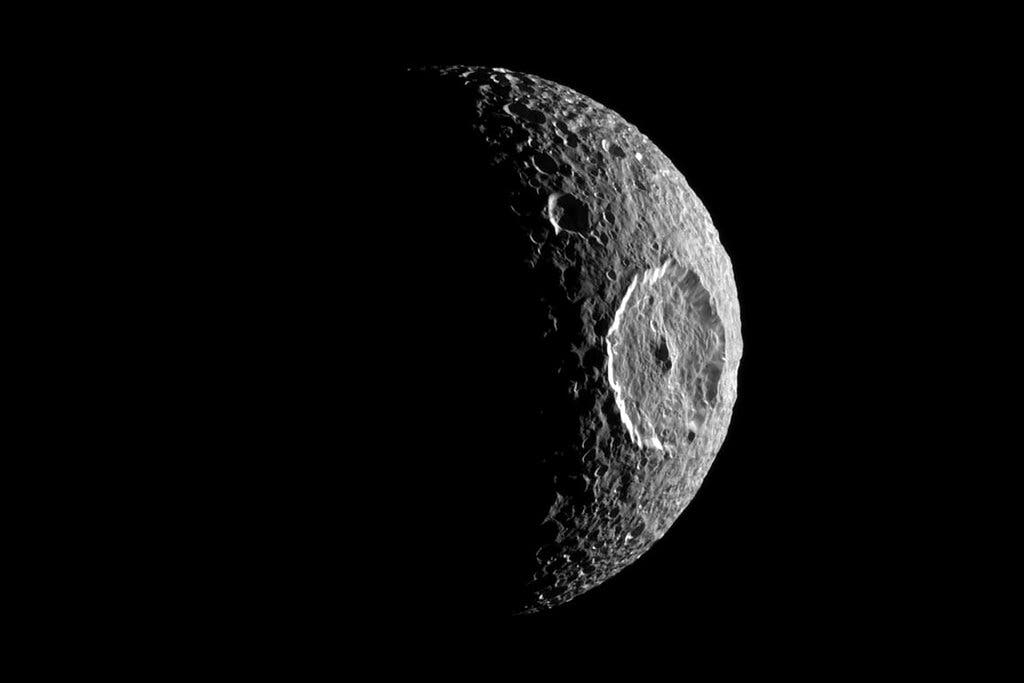
That’s not disturbing at all. While we contemplate the frailty of our atmosphere, it seems like a good time to review other possible places to live in our solar system.
While not useful for humans, new research published in the journal Icarus by Alyssa Rose Rhoden and Matthew Walker details evidence that Saturn’s moon Mimas may have a subsurface ocean.
Most famous for its Death Star-like appearance, this small moon, almost nine times smaller than Earth’s Moon, was briefly explored by the Cassini mission and found to be oscillating in a way indicative of a liquid core. Tidal heating, the regular gravitational squishing of this world, can generate enough heat to keep the insides of this world warm. If the moon’s wobble and the effects of tidal heating are correctly understood, it would mean this world has a 24-31 kilometer thick shell of ice surrounding a massive ocean and a warm core, meaning there could be life.
So, if you are trying to count how many places in our solar system could have life, and I admit, I have given up, you can add one to your surprisingly large list of places.
The story of water in our solar system is ever-changing, and the story of water on Mars, in particular, seems to get more confusing with every new paper.
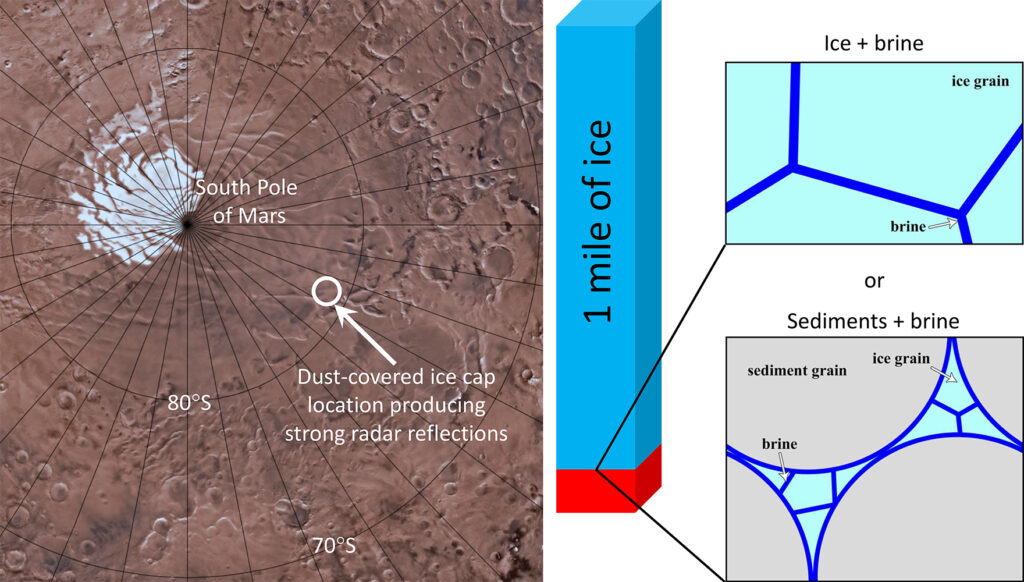
Earlier this week, we brought you news of a January 24 paper in Geophysical Research Letters that explained why Mars probably doesn’t have water under its south polar glaciers, even though bright radar returns are seen. According to that paper, led by Cyril Grima, bright radar returns from under Mars’s south polar ice cap are from lava rock and not water.
Yesterday, January 26, we got early access to a paper that will be published on February 1 in Earth and Planetary Science Letters describing lab experiments run to determine what kinds of salty waters and water-sediment configurations could exist under Mars’s south polar glaciers. As laboratory geophysicist David Stillman explains: The exotic salts that we know exist on Mars have amazing ‘antifreeze’ properties allowing brines to remain liquid down to -103 degrees Fahrenheit. We studied these salts in our lab to understand how they would respond to radar.
We are now in the position of having one research paper that says the bright radar returns that folks originally thought were water are almost definitely not water and another paper saying, “But if it is water, this is how it could exist.” And that is kind of neat.
While it’s possible there could be lakes of deadly perchlorate or chloride brines, Stillman explains: These brines could exist between the grains of ice or sediments and are enough to exhibit a strong dielectric response. This is similar to how seawater saturates grains of sand at the shoreline or how flavoring permeates a slushie but at -103 degrees Fahrenheit below a mile of ice near the South Pole of Mars.
Good job, everyone. Can we please get a drilling rig on Mars? I think we may need to do some digging to understand exactly what is going on.
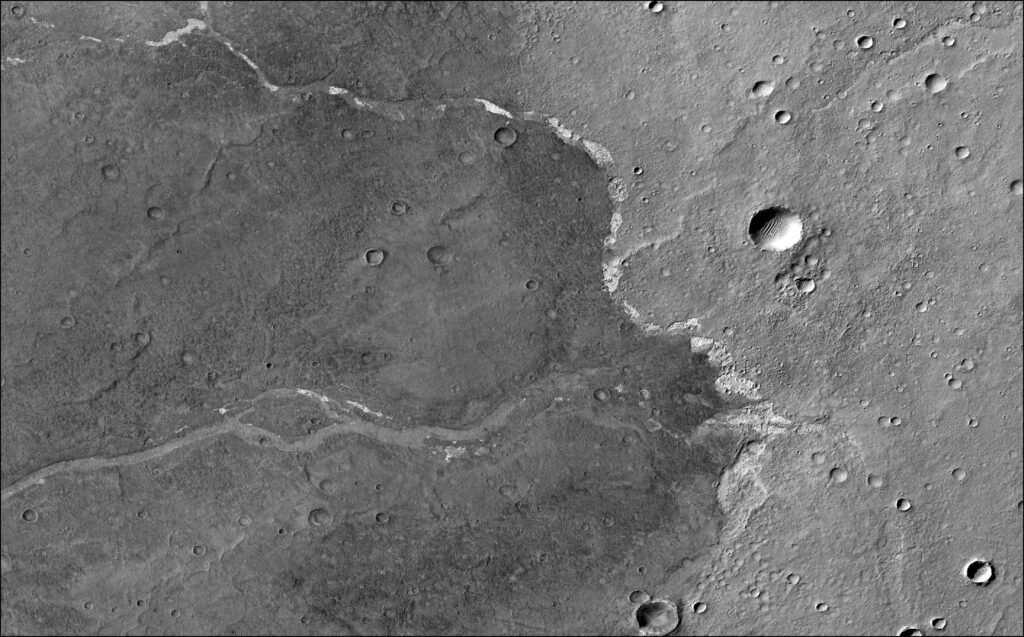
On top of trying to figure out if Mars currently has liquid water somewhere, scientists are also trying to answer the question of how long liquid water was on Mars and when it disappeared – or went underground. We know there was water. There are river and stream channels, gullies, and even sedimentary rocks on Mars that tell us there was water. Previous estimates had the disappearance dating back about 3 billion years.
Now, imagery and data from the Mars Reconnaissance Orbiter have found evidence that liquid water was still on the surface about 2 to 2.5 billion years ago, giving water another billion years or so to provide some of the necessary requirements for life. And they found this evidence by looking at salt deposits left behind in the depressions of long ago ponds on volcanic plains.
The scientists analyzed images by counting craters, which tells us how old the terrain is – more craters equals older terrain underneath. And from their crater counts, they derived the approximate age of the volcanic plains which means the ponds had to be younger than that. Pretty cool, huh? Our Mars missions are working hard, day after day, year after year, to collect amazing data.
This work was published in AGU Advances with lead author Ellen Leask.
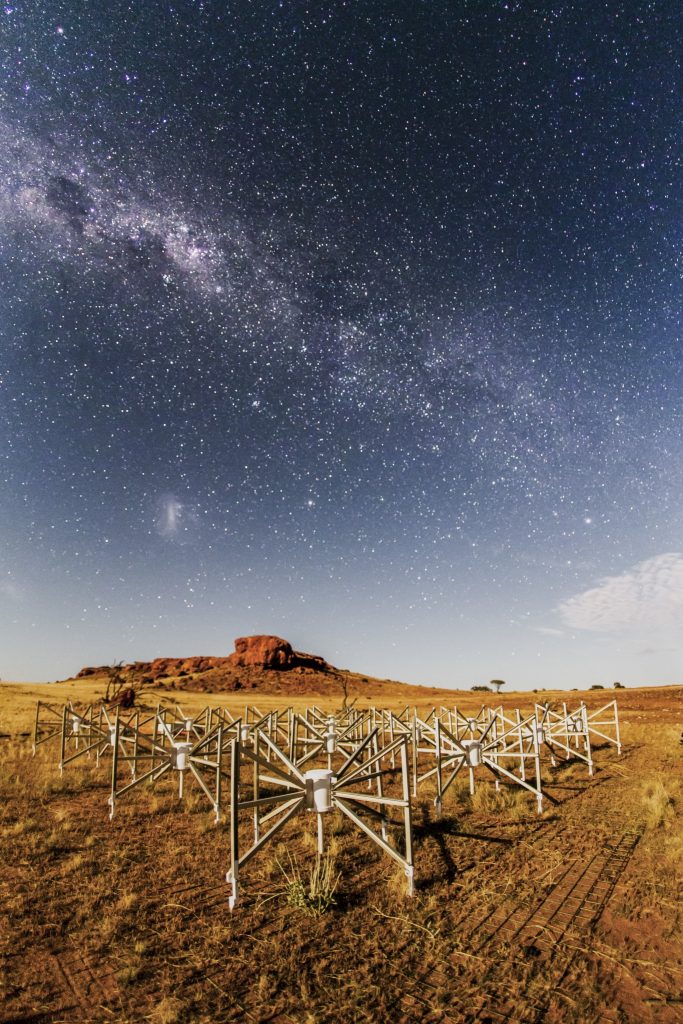
A lot of science boils down to someone, often a student, looking at some data, and someone says something that can be translated to, “Oh that’s weird,” and then a bunch of folks get involved, and a paper is published. A few years later, it starts to be well understood, and if the original researchers are lucky, they may get some cool awards for their one-two punch of being lucky enough to look in the right place or data set and to recognize something worth recognizing is in front of them.
Yesterday, a breaking news story beautifully followed this script. Honors student Tyrone O’Doherty wrote some data reduction routines to look for transient phenomena that come and go in the sky. This kind of software is pretty common for optical and infrared telescopes that search out supernovae and other events, but O’Doherty was using radio data from the Murchison Widefield Array, which looks at the sky in longer wavelengths than earlier telescopes have generally explored. This test platform for technology that will be used in the future Square Kilometer Array is still being pushed to see what it is capable of, and this is where an honors student and some new software come into play.
While doing a look-through of archival data, O’Doherty spotted a breathtakingly bright source or at least a source bright in the not well-explored color of radio light Murchison observes. Oddly, this source would turn on for 30-60 seconds every roughly twenty minutes over several hours, and then it would turn off. Or they got unlucky, and the telescope just wasn’t looking during the 30-60 seconds the object was turned on.
In the journal Nature, in a paper led by Natasha Hurley-Walker, the collaboration writes: At the time of writing, the MWA has been in operation for 8 years and this source was only found to be active for 2 months in that time.
They go on to describe how that implies the object is active 2% of the time or sixty days out of the 3,000 searched.
And this brings me to my new favorite published sentence.
This work looked at archival data, so the time sampling they had was at the whim of when other people were looking in that part of the sky for whatever reason, so the telescope wasn’t making continuous observations. This led them to write: Alternatively, we could assume that the source was active any time that we have not thoroughly searched the data and, with the cooperation of a conspiratorial Universe, the duty cycle can trend towards 100%.
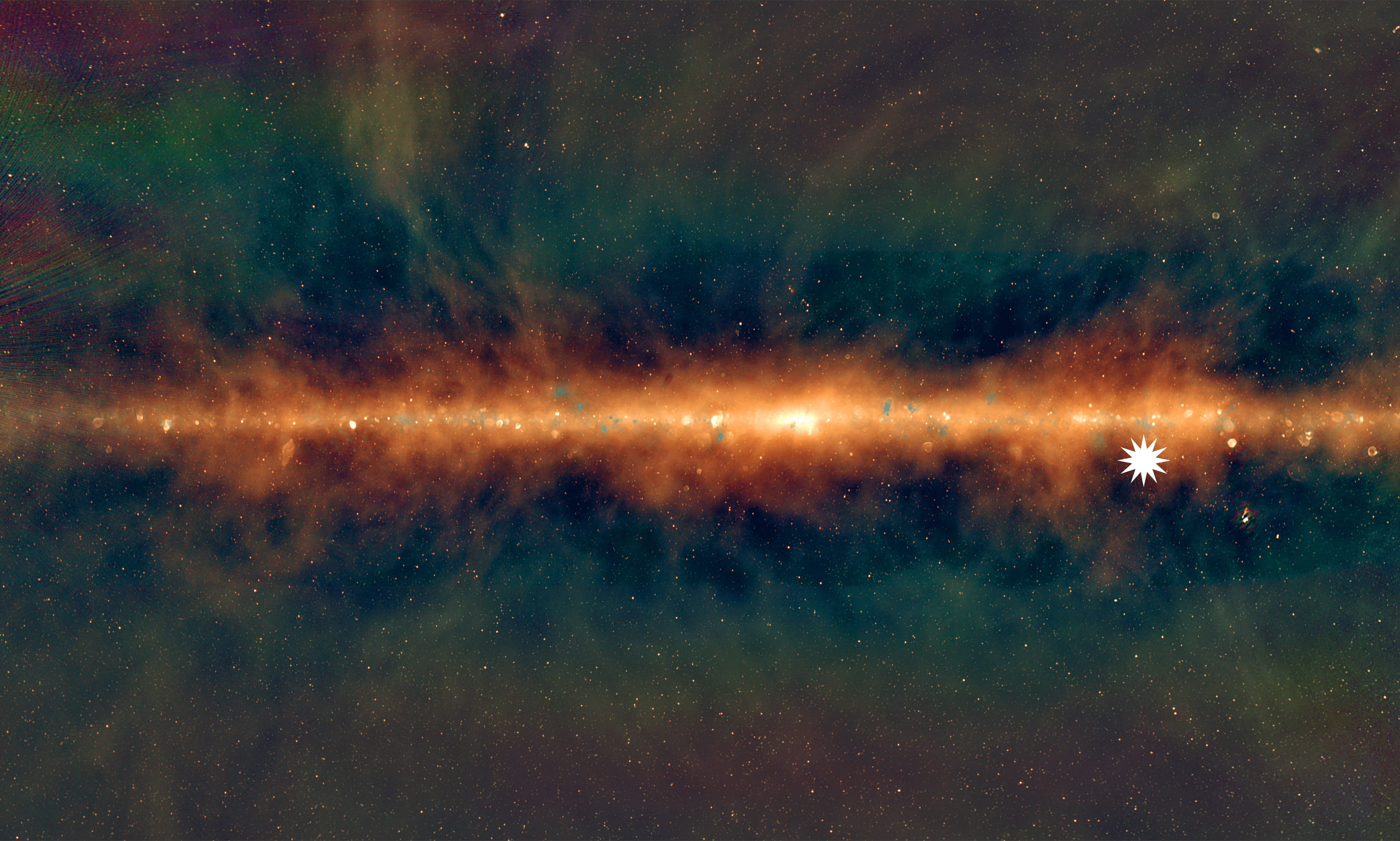
To summarize: A student, who is now a Ph.D. student, writes software to look for things that aren’t constant and finds something weird in pre-existing data, and because it was archival data, I can tell you the object is flashing possibly 2% of the time, possibly only flashed during one sixty-day window that happened to be observed or is flashing all the time, and we’re unlucky.
Mysteries are fun, and I expect folks are going to try and sort how to keep a more steady eye – or telescope – on this particular mystery.
Exactly what it is will require more data, but early predictions hint at this being a slow rotating magnetar — a kind of neutron star with an extremely strong magnetic field. These are different from generic pulsars, and it has been predicted that out there somewhere these slow rotating things should be sending out radio emissions.
We just didn’t think one would turn on just 4,000 light-years away and be so bright. Yes, this object is just 4,000 light-years away.
This is going to be an object to follow. Sadly, as close as it is, this is not something my backyard telescope and I can see, but this is a reminder that if you look at that bright star Sirius, you’re also looking at its little white dwarf neighbor. Compact stars are cool, even if we can’t see them directly.
Need to learn how to use your scope a bit better? We got you covered.
What’s Up

So, you got a telescope for Christmas, or maybe you got one years ago and it’s done nothing but collect dust in a corner ever since. That’s a shame because most telescopes aren’t hard to use. Over the course of the next few weeks, our What’s Up segments will walk you through the steps so that you can take your telescope under the stars and look up.
One of the things beginners struggle with is not seeing the object they’re trying to view in the eyepiece, despite it being centered in the finderscope, so this week I’m going to teach you how to align your finderscope.
The finderscope is a smaller telescope on your main telescope with a wider field of view that helps you locate objects in the night sky. Once you’ve assembled your new telescope, you need to align the finderscope with the main telescope.
But first, let’s talk about the most common types of finderscopes, so you know what kind you have and its advantages and disadvantages.
Finderscopes come in two major types: straight-through and right angle.
The average beginner telescope comes with a very small straight-through finder scope or red dot finder, a type of straight-through finderscope that has a little red dot in the middle of the field of view.
Straight-through finders can be harder to use except at low angles to the horizon because after a while your neck will hurt from straining to look through them. Another disadvantage is the view is reversed left to right compared to your eyes, which may be confusing. One advantage is that the eyepiece of the straight finderscope points in the same direction as the main scope, unlike some of the other styles of finderscopes.
Another common type is the right-angle, correct-image finderscope. As the name suggests, it has an eyepiece that is at a right angle to the finderscope body. This type of finderscope is easier on your body because you usually don’t need to contort yourself to look along the telescope axis. Right angle finderscopes mainly come in one type – correct image – which means they contain optics to flip the image so that it matches your eye’s view.
You can have either or both of these types of finderscopes installed on your telescope at the same time with a special adapter. Many people do since the two types are good for different things.
There are other types of finderscopes that are more specialized. One of these is the Telrad. A Telrad is a more advanced straight-through finder, with three concentric circles projected on an angled piece of glass. They contain no other optics so they don’t magnify the view, unlike the more common finderscopes, but this is a good thing because it allows you to use both eyes to find fainter stars. The three circles are at 0.5, 2, and 4 degrees, allowing you to use star charts (preferably paper to save your night vision!) to hop from star to star to your deep-sky target. We’ll tell you about star hopping in a future What’s Up.

Now to what you’ve been waiting for: how to align one of these finderscopes with your main telescope and actually find one of those faint fuzzies in the sky!
The main principle of aligning the finderscope is to start by aligning with things that are close to you and repeating the process with things that are further and further away so that objects in the finderscope will be visible through the eyepiece, even at higher magnifications.
The first step is to sight along the telescope at a stationary object, like a tree in the distance, so that the object is roughly in the eyepiece. Finding an object far enough away for this can be a challenge, particularly in suburban environments. Nevertheless, center it in the eyepiece, then look at the finderscope. The finderscope will have two or three adjustment knobs or screws, which may require a screwdriver to be adjusted. Experiment with how the knobs or screws affect the alignment and make adjustments so that the reticle – those lines in your view through the finderscope – is centered on the target in the distance. This is the basic process for aligning the finder scope.
You should repeat this process with something that is farther away; since the finderscope is roughly aligned from the first step, you can align it with the Moon. Center the Moon in the telescope eyepiece and then realign the finderscope so that the center is aimed at the same point on the Moon.
Finally, repeat this process on a star for the most accurate alignment. Once you’ve taken these steps, you’re ready to look at something else in the sky.
So, take that telescope, go outside, and look up.
Your random space fact for this week is the second stage of the Falcon 9 rocket that launched the DSCOVR spacecraft in 2015 is predicted to impact the far side of the Moon in March of this year.
This has been the Daily Space.
You can find more information on all our stories, including images, at DailySpace.org. As always, we’re here thanks to the donations of people like you. If you like our content, please consider joining our Patreon at Patreon.com/CosmoQuestX.
Credits
Written by Pamela Gay, Beth Johnson, and Erik Madaus
Hosted by Pamela Gay and Beth Johnson
Audio and Video Editing by Ally Pelphrey
Content Editing by Beth Johnson
Intro and Outro music by Kevin MacLeod, https://incompetech.com/music/


 We record most shows live, on Twitch. Follow us today to get alerts when we go live.
We record most shows live, on Twitch. Follow us today to get alerts when we go live.